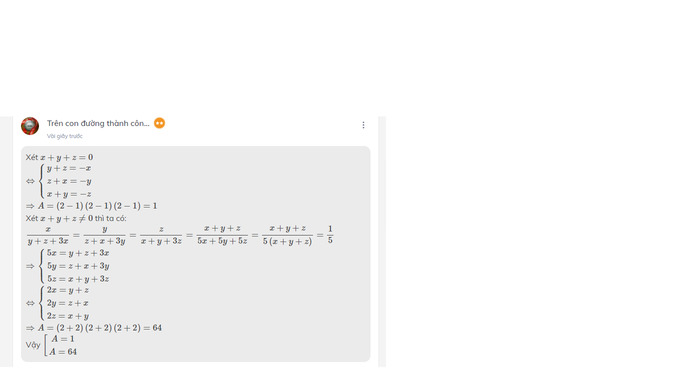Hãy nhập câu hỏi của bạn vào đây, nếu là tài khoản VIP, bạn sẽ được ưu tiên trả lời.

( x - 1 )2018 + (y - 2 )2020+(z-3)2022=0
\(\Leftrightarrow\left\{{}\begin{matrix}x-1=0\\y-2=0\\z-3=0\end{matrix}\right.\Leftrightarrow\left\{{}\begin{matrix}x=1\\y=2\\z=3\end{matrix}\right.\)
\(A=\dfrac{1}{9}\left(-x\right)^{2021}y^2z^3=\dfrac{1}{3}\left(-1\right)^{2021}.2^2.3^3=\dfrac{1}{3}.\left(-1\right).4.27=-36\)

(3x - 1)^2016 + (5y - 3)^2016 < 0 (1)
có (3x - 1)^2016 > 0
(5y - 3)^2018 > 0
=> (3x-1)^2016 + (5y - 3)^2018 > 0 và (1)
=> (3x - 1)^2016 + (5y - 3)^2016 = 0
=> 3x - 1 = 0 và 5y - 3 = 0
=> x = 1/23 và y = 3/5

Xét \(x+y+z=0\)
\(\Leftrightarrow\left\{{}\begin{matrix}y+z=-x\\z+x=-y\\x+y=-z\end{matrix}\right.\)
\(\Rightarrow A=\left(2-1\right)\left(2-1\right)\left(2-1\right)=1\)
Xét \(x+y+z\ne0\) thì ta có:
\(\dfrac{x}{y+z+3x}=\dfrac{y}{z+x+3y}=\dfrac{z}{x+y+3z}=\dfrac{x+y+z}{5x+5y+5z}=\dfrac{x+y+z}{5\left(x+y+z\right)}=\dfrac{1}{5}\)
\(\Rightarrow\left\{{}\begin{matrix}5x=y+z+3x\\5y=z+x+3y\\5z=x+y+3z\end{matrix}\right.\)
\(\Leftrightarrow\left\{{}\begin{matrix}2x=y+z\\2y=z+x\\2z=x+y\end{matrix}\right.\)
\(\Rightarrow A=\left(2+2\right)\left(2+2\right)\left(2+2\right)=64\)
Vậy \(\left[{}\begin{matrix}A=1\\A=64\end{matrix}\right.\)
Nếu bị lỗi thì bạn có thể xem đây nhé:


Ta có: \(\hept{\begin{cases}\left(2021x-1\right)^{2020}\ge0\\\left(3y+4\right)^{2022}\ge0\end{cases}}\left(\forall x,y\right)\)
\(\Rightarrow\left(2021x-1\right)^{2020}+\left(3y+4\right)^{2022}\ge0\left(\forall x,y\right)\)
Mà theo đề bài ta có: \(\left(2021x-1\right)^{2020}+\left(3y+4\right)^{2022}\le0\)
Nên từ đó suy ra: \(\hept{\begin{cases}\left(2021x-1\right)^{2020}=0\\\left(3y+4\right)^{2022}=0\end{cases}}\Leftrightarrow\hept{\begin{cases}2021x-1=0\\3y+4=0\end{cases}}\Leftrightarrow\hept{\begin{cases}x=\frac{1}{2021}\\y=-\frac{4}{3}\end{cases}}\)
Khi đó \(M=2021\cdot\frac{1}{2021}\cdot\left(-\frac{4}{3}\right)-\left(-\frac{4}{3}\right)^2\)
\(=-\frac{4}{3}-\frac{16}{9}=-\frac{28}{9}\)

Nhận xét : ( x + y - 3 )^2018 >=0 và 2018.(2x-4)^2020 >= 0
=> (x+y-3)^2018 + 2018.(2x-4)^2020 >=0
Dấu = xảy ra khi : x + y - 3 = 0 và 2x - 4 = 0 => x = 2 và y = 1
Thay vào bt S :
S = ( 2 - 1)^2019 + (2-1)^2019
= 1^2019 + 1^2019 = 2

a, \(A=\left(x+2y\right)^2-x+2y\)
Thay x = 2 ; y = -1 ta được
\(A=\left(2-2\right)^2-2-2=-4\)
b, Ta có \(\left(x^2+4>0\right)\left(x-1\right)=0\Leftrightarrow x=1\)
Thay x = 1 vào B ta được \(B=3+8-1=10\)
c, Thay x = 1 ; y = -1 ta được
\(C=3,2.1.\left(-1\right)=-3,2\)
d, Ta có \(x=\left|3\right|=3;y=-1\)Thay vào D ta được
\(D=3.9-5\left(-1\right)+1=27+5+1=33\)
thay x=2,y=-1 vào biểu thức A ta có;
A=(2+2.(-1)^2-2+2.(-1)
A=(2+-2)^2-2+-2
A=0-2+-2
A=-4
b)
(x^2+4)(x-1)=0
suy ra x-1=0(x^2+4>0 với mọi x thuộc thuộc R)
(+)x-1=0
x =1
thay x=1 vào biểu thức B ta có;
B=3.1^2+8.1-1
B=3.1+8-1
B=3+8-1
B=10
c)thay x=1 và y=-1 vào biểu thức C ta có;
C=3,2.1^5.(-1)^3
C=3,2.1.(-1)
C=(-3,2)
d)giá trị tuyệt đối của 3=3 hoặc (-3)
TH1;thay x=3:y=-1 vào biểu thức d ta có;
D=3.3^2-5.(-1)+1
D=3.9-(-5)+1
D=27+5+1
D=33

Ta có:
\(\left|x-1\right|+\left(y+2\right)^{20}=0\)
\(\Rightarrow\left|x-1\right|=0\) và \(\left(y+2\right)^{20}=0\)
+) \(\left|x-1\right|=0\Rightarrow x-1=0\Rightarrow x=1\)
+) \(\left(y+2\right)^{20}=0\Rightarrow y+2=0\Rightarrow y=-2\)
\(\Rightarrow C=2x^5-5y^3+2015\)
\(=2.1^5-5.\left(-2\right)^3+2015\)
\(=2-\left(-40\right)+2015\)
\(=2057\)
Vậy C = 2057


1)3x4-5x3y+6x2-10xy+2
=(3x4-5x3y)+(6x2-10xy)+2
=x3(3x-5y)+2x(3x-5y)+2
=x3.0+2x.0+2
=0+0+2
=2
2) x5-2010x4+2010x3-2010x2+2010x-2020
=x5-(2009+1)x4+(2009+1)x3-(2009+1)x2+(2009+1)x-2009-11
=x5-(x+1)x4+(x+1)x3-(x+1)x2+(x+1)x-x-11
=x5-x5-x4+x4+x3-x3-x2+x2+x-x-11
=-11
2, Với x= 2009 => 2010=x+1
=> \(x^5-2010\text{x}^4+2010\text{x}^3-2010\text{x}^2+2010\text{x}-2020=x^5-\left(x+1\right)x^4+\left(x+1\right)x^3-\left(x+1\right)x^2+\left(x+1\right)x-2020\)
\(=x^5-x^5-x^4+x^4+x^3-x^3-x^2+x^2+x-2020\)
\(=x-2020\)
\(=2009-2020\\ =-11\)